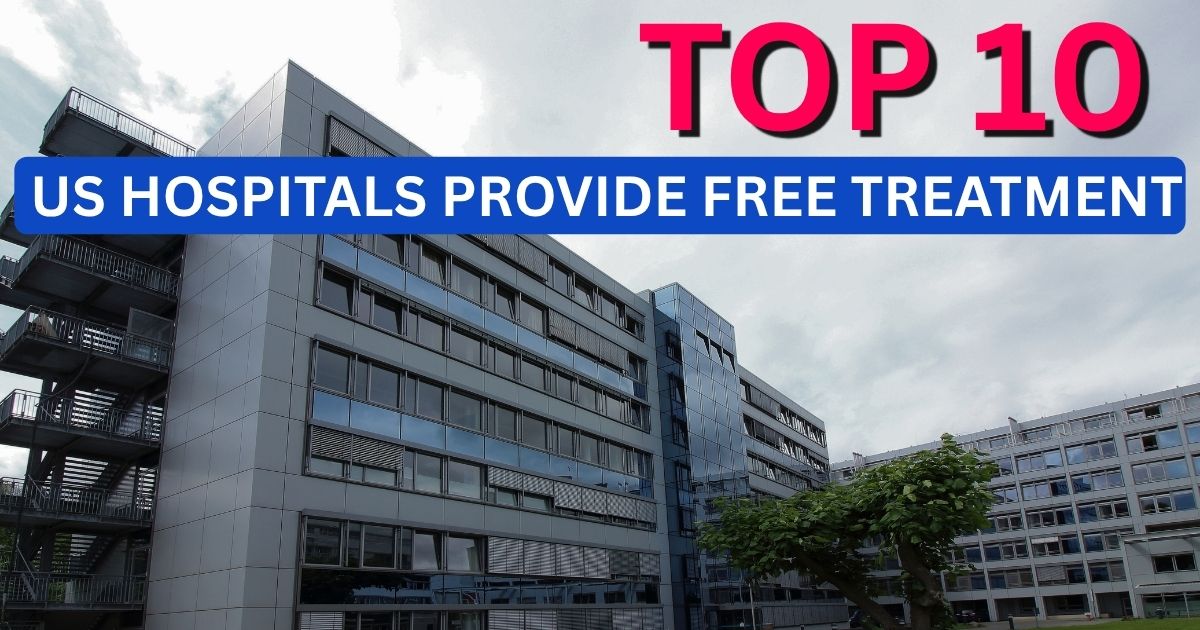US Hospitals Provide Free Treatment – Healthcare in the United States is among the most expensive in the world, which poses a serious challenge for millions of low-income individuals. Fortunately, several leading hospitals across the country offer free or heavily discounted medical treatment to patients who cannot afford to pay. These programs, known as charity care or financial assistance, aim to provide essential health services to everyone, regardless of their ability to pay.
In this comprehensive article, we explore which US hospitals provide free treatment for low-income patients, how these programs work, and how individuals can access them. Whether you’re uninsured, underinsured, or simply struggling with medical debt, this guide will help you navigate your options with confidence.
Why Do Some Hospitals Offer Free Care?
Under federal law, nonprofit hospitals are required to offer financial assistance programs to remain tax-exempt. These programs must be made available to patients who meet certain income and residency criteria. In addition, many public and safety-net hospitals, particularly those serving Medicaid and Medicare populations, offer comprehensive support for uninsured and low-income residents.
Faith-based and private hospitals also offer charity care as part of their commitment to community health and patient advocacy. These institutions understand the critical role they play in bridging healthcare disparities and promoting equitable access.
Understanding Charity Care Programs
Charity care programs are hospital-administered initiatives that provide free or reduced-cost healthcare to eligible patients. These programs typically cover emergency services, medically necessary procedures, surgeries, and sometimes even long-term care or prescription assistance.
Each hospital sets its own eligibility guidelines, but most programs follow a similar framework.
Common features include:
- Income-based eligibility
- Proof of residency requirements
- Full coverage for patients earning below a specific income threshold
- Sliding scale discounts for patients earning slightly above the threshold
- Application process requiring documentation such as pay stubs, tax returns, or benefit letters
Top US Hospitals Providing Free Treatment to Low-Income Patients
Below is a list of leading hospitals in the United States that offer extensive charity care programs.
1. Cleveland Clinic (Cleveland, Ohio)
Cleveland Clinic is one of the most respected healthcare institutions in the country. As a nonprofit hospital, it offers financial assistance for uninsured and low-income patients.
Key features:
- Full financial assistance for patients earning up to 250% of the Federal Poverty Level (FPL)
- Partial discounts up to 400% FPL
- Comprehensive support through its Financial Assistance Program
Visit their official website for details: Cleveland Clinic Financial Assistance
2. Mayo Clinic (Rochester, MN; Phoenix, AZ; Jacksonville, FL)
Mayo Clinic is globally renowned for its clinical excellence and research. It also offers robust financial assistance for patients in need.
Key features:
- Full coverage for patients with income up to 200% of the FPL
- Sliding scale assistance up to 400% of the FPL
- Available across all Mayo Clinic campuses
3. Johns Hopkins Hospital (Baltimore, Maryland)
As a leading teaching and research hospital, Johns Hopkins provides a wide range of charity care services, particularly to Maryland residents.
Key features:
- Eligibility for those earning up to 300% of the FPL
- Emergency and specialty care included
- Services for uninsured and underinsured individuals
4. Massachusetts General Hospital (Boston, MA)
Mass General is part of the Mass General Brigham health system and offers strong financial assistance under state and federal laws.
Key features:
- Services offered under Massachusetts’ Health Safety Net program
- Care available regardless of insurance or immigration status
- Financial counselors assist with applications and Medicaid enrollment
5. UCSF Medical Center (San Francisco, CA)
UCSF is one of the nation’s top academic medical centers and offers free or low-cost care to qualifying California residents.
Key features:
- Assistance for patients earning under 400% of the FPL
- State-mandated charity care requirements
- Inclusive of immigrants and uninsured residents
6. Parkland Health and Hospital System (Dallas, TX)
Parkland Health is Dallas County’s primary safety-net hospital, serving thousands of low-income patients every year.
Key features:
- Parkland Financial Assistance Program covers hospital services
- Eligibility includes county residency and income under 250% of the FPL
- Maternity, emergency, surgical, and primary care available
7. Grady Memorial Hospital (Atlanta, GA)
Grady is one of the largest public hospitals in the United States and a critical provider of care for Atlanta’s uninsured population.
Key features:
- Financial assistance for patients earning less than 200% of the FPL
- Covers trauma, cancer, and specialty services
- On-site financial counselors guide patients through application
8. Harbor-UCLA Medical Center (Los Angeles, CA)
This hospital is part of the Los Angeles County Department of Health Services and offers care to all residents, regardless of immigration status.
Key features:
- Free or low-cost services for residents under 350% of the FPL
- Emergency, primary, pediatric, and mental health services
- In-person help for applying to government health programs
9. Bellevue Hospital (New York City, NY)
Bellevue is the oldest public hospital in the U.S. and a central part of NYC Health + Hospitals, which provides universal access to care.
Key features:
- Free and low-cost care through NYC Care
- No insurance or immigration status required
- Primary, emergency, mental health, and chronic disease management
10. Cook County Health (Chicago, IL)
Cook County Health is a safety-net system serving the uninsured population of Chicago and surrounding areas.
Key features:
- Financial assistance based on income and residency
- Services include specialty care, surgeries, and preventive services
- Undocumented immigrants often eligible for charity care
What Are Federally Qualified Health Centers (FQHCs)?
Beyond hospitals, Federally Qualified Health Centers (FQHCs) offer low-cost or free primary care services across all 50 states. These centers are funded by the Health Resources and Services Administration (HRSA) and serve everyone regardless of income or insurance status.
FQHC services include:
- Preventive checkups
- Immunizations
- Mental health and substance abuse treatment
- Women’s health and family planning
- Sliding fee scale based on income
You can find an FQHC near you using the HRSA Health Center Locator: HRSA Find a Health Center
Do You Qualify for Free Treatment?
Eligibility varies by hospital, but typically includes:
- Income under a certain percentage of the FPL (usually between 200% and 400%)
- Proof of income, such as pay stubs or tax returns
- Proof of residency in the service area
- Citizenship or immigration documentation may or may not be required, depending on the state
Some programs also consider family size, disability status, or employment history.
How to Apply for Charity Care
Follow these steps to apply for financial assistance:
- Contact the hospital’s billing or financial assistance office
- Ask for the Financial Assistance Application (also available online)
- Submit required documents, including proof of income and residency
- Wait for eligibility determination, which usually takes 1–4 weeks
- If approved, you may receive full or partial forgiveness of your medical bills
It’s advisable to apply as early as possible, especially if you are facing a scheduled surgery or ongoing treatment.
What If You Don’t Qualify?
If you are denied charity care, consider these alternatives:
- Set up a payment plan with the hospital. Many offer interest-free options.
- Apply for Medicaid or state-sponsored insurance. Some states offer retroactive coverage for recent medical expenses.
- Visit a free clinic or community health center for non-emergency services.
- Use prescription assistance programs from drug manufacturers.
- Contact organizations like RIP Medical Debt, which helps low-income individuals eliminate existing medical debt.
Real Stories: How Charity Care Changes Lives
Many patients across the United States have benefitted from charity care programs. For example, Cleveland Clinic reports providing hundreds of millions of dollars in free care each year. Patients include those who lost employment during the pandemic, gig workers without insurance, and undocumented immigrants requiring urgent surgery.
In New York City, Bellevue Hospital’s NYC Care program has allowed thousands of people to receive life-saving care without facing bankruptcy. These programs are often the last safety net for those with no other healthcare options.
External Resources to Explore
Here are some official resources to help you find affordable or free healthcare:
- Healthcare.gov – Learn about insurance options, Medicaid, and CHIP programs
- RIP Medical Debt – Non-profit that forgives medical debt for qualifying individuals (ripmedicaldebt.org)
- National Association of Free & Charitable Clinics – Find free clinics by zip code (nafcclinics.org)
- HRSA Health Center Locator – Federally funded clinics across the U.S. (findahealthcenter.hrsa.gov)
Conclusion
Access to healthcare is a fundamental human need, and fortunately, there are systems in place to support individuals who are unable to pay. Whether you are uninsured, underemployed, or navigating financial hardship, many US hospitals are committed to providing quality care through charity and financial assistance programs.
Before assuming that you cannot afford treatment, explore these resources, speak with hospital financial counselors, and apply for assistance. A proactive approach can ensure that you or your loved ones receive necessary medical services without the burden of overwhelming costs.

